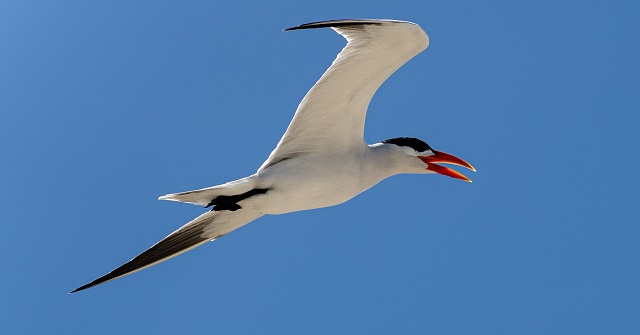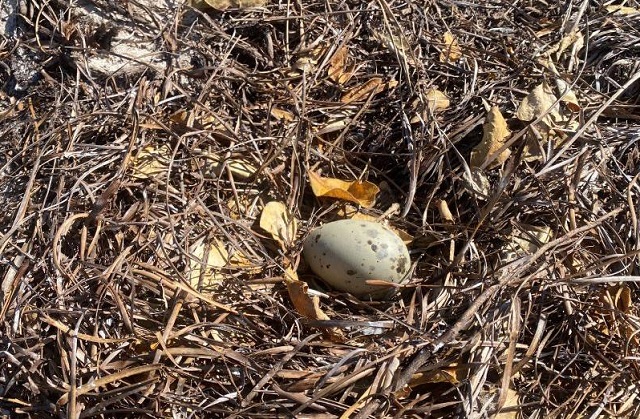World's largest tern: Caspian tern spotted breeding on Seychelles' Cosmoledo Atoll

The important discovery was made in May by the ICS team on the atoll. (Jake Letori)
The world's largest tern, the Caspian tern, has been spotted breeding on Cosmoledo Atoll, making it the second oceanic breeding site in Seychelles after the Aldabra Atoll.
Jake Letori, a conservation officer of the Island Conservation Society (ICS) based on Cosmoledo, told SNA that this important discovery was made in May by the ICS team on the atoll.
"It was an opportunistic sighting. The team went out to explore Menai, the largest island of the atoll, which is an island that was new to them. We always keep an eye and an ear out for birds, and we were mobbed by both adults, which led us to believe they might be nesting nearby. Upon settling on the ground, we were able to see their nesting location and confirm the presence of an egg. We took a photo and a GPS location then departed," said Letori.
He told SNA that he could not give an accurate population estimate of the Caspian tern but "so far we know of one pair on Grande Ile that potentially raised two young and we've seen a pair on Menai. We've never seen more than four at one time on Cosmoledo, usually sighted in pairs or singular."
Caspian tern eggs are larger than other terns that nest in Seychelles, which include the black-naped tern, the sooty tern, the brown noddy, and fairy terns. It is pale in colour with speckled mottled brown and blends in with the ground. Over time they become faded and get an earthy colour from incubation.
Letori said there are a couple of reasons why the Caspian tern has chosen to nest on Comsoledo.
"One is that there is no permanent human habitation here, therefore, very little disturbance. They are able to nest in peace as they are very sensitive and skittish birds. Also, the Cosmoledo lagoon and outer reefs provide perfect foraging habitat for them to catch small fish, as well as plenty of sandy beaches. We've seen them catch turtle hatchlings from the beach and the sea," he explained.
He added that "for the nest on Menai, we were unable to tell whether it fledged or failed as we returned too late to check. Menai has rats which could be a threat, herons also may pose a threat to small chicks."
 |
| Caspian tern eggs are larger than other terns that nest in Seychelles. (Jake Letori) Photo License: All Rights Reserved |
Letori said that the nests have been officially recorded to his understanding and this is good news for Seychelles, an archipelago in the western Indian Ocean, because it shows that the breeding population is not isolated to Aldabra.
"If anything was to happen to a population that only breeds on one island then they can be locally extirpated (eradicated). We also believe they are breeding on Astove Atoll and have seen certain behaviour that suggests so, but we cannot officially confirm," said Letori.
This is good news in general for the Aldabra Group of islands and adds to the importance of Cosmoledo as a seabird hotspot and as an Important Bird Area (IBA) – an internationally recognised area for bird conservation - not to mention the important ecological roles seabirds play in the connectivity of marine and terrestrial environments.
Letori has observed that the Caspian tern breeding occurs in the southeast monsoon season, usually between April and August.
"Adults will express a black cap that connects to the red bill and a small crest of feathers on the back of the cap. We see them in high aerial chases with each other, making loud harsh calls. To me it sounds like a bark. They also chase other birds, including herons, frigatebirds, and other terns, seeming to be very territorial over roosting or foraging sites. But they nest almost in isolated pairs, we've never seen them in a colony here," he explained.
Letori however pointed out that rats are definitely a threat to the island ecosystems and ground-nesting seabirds as they will predate on eggs and small chicks that are unable to defend themselves.
This especially occurs during the southeast monsoon when food and water resources are low but there is an abundance of eggs and young birds.
"But the adult Caspian terns are very protective and once a chick gets to a certain mobile stage it can defend itself. I cannot really say for sure how the rats are impacting the breeding success of the Caspian terns, but as an invasive species rats are a threat," he added.
Letori said that since the arrival of the team on the island is fairly recent and there has been no monitoring of the terns, he cannot say that they have seen rats predate on eggs and young.
"ICS was involved in the eradication of rats from Grande Ile and Grande Polyte and ground-nesting seabird numbers seemed to have boomed, namely masked boobies, and red-tailed tropicbirds, but we do not have current estimates," he added.





